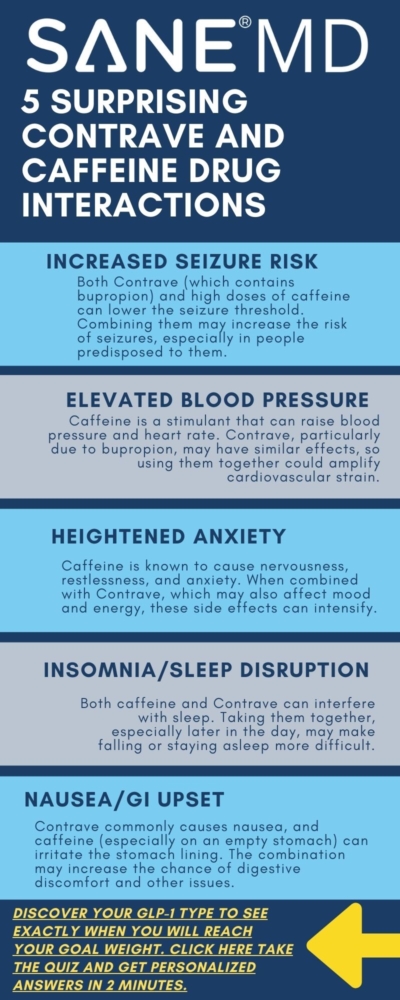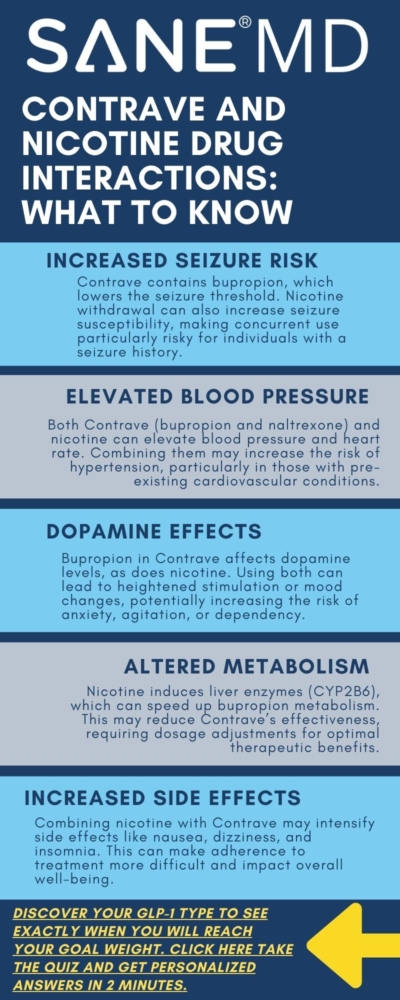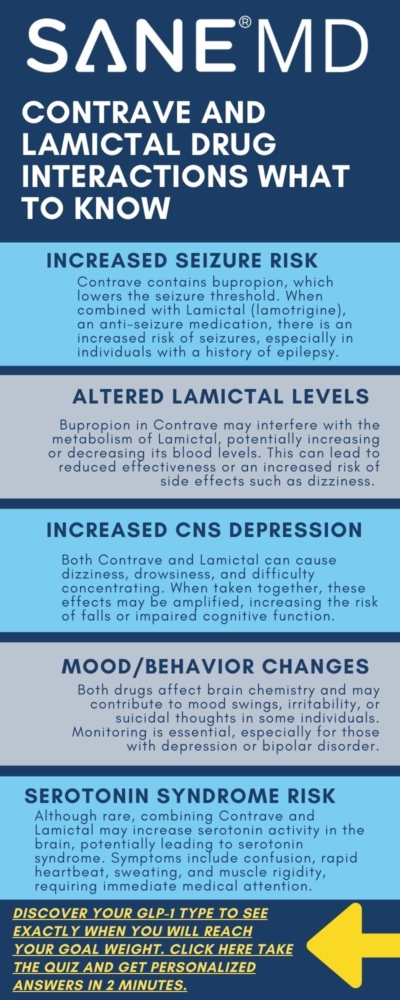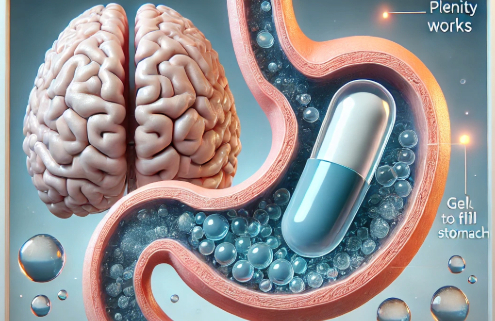Surprising Contrave and Caffeine Drug Interactions to Know

The combination of prescription weight loss drugs and everyday stimulants can lead to unexpected effects—especially when the drug in question is Contrave, and the stimulant is caffeine. Many people take Contrave as part of a long-term weight management plan, unaware that their morning coffee or energy drink might interact with it in ways that could affect their health or the drug’s effectiveness.
Contrave, a combination of bupropion naltrexone, is FDA-approved for chronic weight management in certain adults with an initial body mass index (BMI) of 30 or more (or 27+ with weight-related conditions like high blood pressure or heart disease).
However, this medication’s two active ingredients—bupropion hydrochloride and naltrexone—can have complex effects when taken with other substances, including dietary supplements, energy drinks, and over-the-counter drugs that contain caffeine.
Key Takeaways
- Combining caffeine and Contrave may increase blood pressure and raise the risk of seizures, especially in sensitive individuals.
- Caffeine, like bupropion, can stimulate the central nervous system, possibly compounding side effects such as insomnia, anxiety, and suicidal thoughts.
- Individuals with medical conditions, especially seizure disorders, bipolar disorder, or heart disease, should discuss caffeine use with their healthcare provider before taking Contrave.
Key Contrave and Caffeine Drug Interactions
| Interaction Area | Details | Risk Level | Recommendations |
|---|---|---|---|
| Seizure Risk | Both caffeine and bupropion (in Contrave) stimulate the central nervous system and lower the seizure threshold. | High | Limit caffeine, especially in early treatment. Avoid energy drinks and high-dose caffeine sources. |
| Blood Pressure Elevation | Caffeine and Contrave can both increase blood pressure, particularly dangerous in those with hypertension or heart conditions. | Moderate to High | Monitor blood pressure regularly. Discuss caffeine intake with your healthcare provider. |
| Worsening of Side Effects | Caffeine may intensify side effects like insomnia, nausea, anxiety, restlessness, and increased heart rate. | Moderate | Reduce caffeine if symptoms worsen. Track side effects and report persistent issues to your provider. |
| Serotonin Syndrome Risk | Bupropion influences the serotonergic neurotransmitter system; combined stimulant use, including caffeine, increases theoretical risk that serotonin syndrome occurs. | Low to Moderate | Avoid combining Contrave with other serotonergic or stimulant substances. Monitor for symptoms. |
| Drug Absorption with High-Fat Meals | High-fat foods increase systemic exposure to Contrave, which can enhance both therapeutic and adverse effects, including seizure risk. | High (if unmanaged) | Avoid high-fat meals when taking Contrave. Choose low- to moderate-fat meals instead. |
| Alcohol Use | Alcohol lowers the seizure threshold and may worsen mental health effects such as suicidal thoughts. | High (in some users) | Avoid or strictly limit alcohol, particularly if you have a history of mood disorders or substance use. |
| Underlying Medical Conditions | Patients with seizure disorder, bipolar disorder, heart disease, or liver problems are at greater risk of serious complications. | High | Thoroughly review your health history with your provider before starting Contrave. |
| Over-the-Counter & Hidden Caffeine | Caffeine is often present in OTC medications (e.g., headache relief), dietary supplements, and energy products. | Moderate | Read labels carefully. Tell your provider about all substances you take, including supplements. |
What Is Contrave and How Does It Work?
Contrave combines bupropion naltrexone in a single tablet. Bupropion, commonly used as an antidepressant and smoking cessation aid, impacts the dopaminergic effects in the brain. Naltrexone, on the other hand, is an opiate agonist antagonist used to treat opioid dependence and opioid withdrawal symptoms.
Together, they target the reward center and appetite regulatory systems in the brain, helping reduce cravings and increase satiety for compatible individuals. Together, they target the reward center and appetite regulatory systems in the brain, helping reduce cravings and increase satiety for compatible individuals. If you’re also taking Rybelsus, it’s important to understand how these medications may interact—read our guide on Taking Contrave and Rybelsus Together Drug Interactions.
When used alongside a reduced-calorie diet and exercise, Contrave can support long-term weight loss and weight management.
However, both components, especially bupropion, come with a well-known boxed warning about the risk of seizures and suicidal thoughts, making it critical to consider potential drug interactions, including those with caffeine and other drugs.
How Caffeine Affects the Body
Caffeine is a stimulant found in coffee, tea, soda, energy drinks, and many over-the-counter headache medications. It works by blocking adenosine, a neurotransmitter that promotes sleep, thereby increasing alertness and energy levels. It also stimulates the release of adrenaline, which can increase blood pressure, heart rate, and metabolic activity.
Although caffeine is widely used and generally safe in moderation, it can affect people differently depending on individual risk factors, existing medical conditions, and other medications being taken. In combination with weight loss drugs like Contrave, the effects of caffeine can become unpredictable.
“Contrave on its own already affects brain chemistry,” explains Dr. Matthew Olesiak, Chief Medical Director at SANE MD. “Adding caffeine to the mix can amplify stimulation of the central nervous system, potentially leading to anxiety, restlessness, or more severe side effects like increased seizure risk.”
Why Caffeine and Contrave Don’t Always Mix Well
When it comes to Contrave and caffeine drug interactions, the concern isn’t just theoretical—it’s rooted in the physiological effects both substances have on the brain and body. Contrave contains bupropion, naltrexone, and caffeine, which is a widely consumed stimulant found in coffee, tea, sodas, energy drinks, and many over-the-counter drugs.
While each may be tolerated on its own, combining them can heighten certain health risks—especially for individuals with preexisting medical conditions, other risk factors, or sensitivity to stimulants.
1. Caffeine Can Increase the Risk of Seizures
Bupropion, one of the active components in Contrave, is associated with a dose-dependent risk of seizures. It’s well-documented that the seizure threshold is lowered by bupropion, meaning even mild additional stimulation can lead to serious neurological events in vulnerable individuals. Caffeine, which stimulates the central nervous system, may contribute to this increased risk—especially when consumed in large amounts, or in combination with other stimulants or dietary supplements.
For individuals with a history of seizure disorder, excessive caffeine intake while taking Contrave could lead to unpredictable side effects and adverse reactions.
2. Potential for Elevated Blood Pressure
Both caffeine and Contrave have the potential to increase blood pressure. Bupropion can cause cardiovascular stimulation, and naltrexone may indirectly influence blood pressure via interactions with the nervous system. When caffeine is added to the mix—especially in high doses—it can intensify these effects. Read about the impact of Contrave on blood pressure in our comprehensive guide.
This combination can be particularly concerning for patients who already have high blood pressure or who are on medications to manage heart disease or other cardiovascular health conditions. It’s critical to monitor patients closely and to evaluate whether dose adjustment or caffeine reduction is necessary.
3. Caffeine Can Mimic or Worsen Side Effects
Many of the commonly reported side effects of Contrave—such as nausea, insomnia, restlessness, irritability, and elevated heart rate—closely mirror those caused by caffeine. Taking the two together can not only intensify these adverse effects but also make it more difficult to determine which substance is responsible for the symptoms. This overlap can reduce a patient’s tolerance for taking Contrave and increase the likelihood of discontinuing treatment early.
Individuals who experience jitteriness or disrupted sleep should consider lowering their caffeine intake to assess whether symptoms improve.
4. Caffeine and the Serotonergic Neurotransmitter System
While caffeine does not directly target serotonin receptors, it can influence the broader neurochemical environment, especially when taken with medications like bupropion that modulate neurotransmitters. Bupropion indirectly affects the serotonergic neurotransmitter system, and although the risk is lower than with SSRIs or other antidepressants, combining bupropion with other stimulating agents has been linked to rare cases in which serotonin syndrome occurs.
A 2022 case report published in Cureus documented serotonin syndrome triggered by excessive caffeine intake in a patient taking serotonergic medications, highlighting that even nonmedicinal substances like coffee can contribute to serotonin toxicity under certain conditions. High caffeine intake, particularly in conjunction with other medications that affect serotonin or dopamine, may theoretically contribute to a serotonin syndrome risk profile.
Side Effects to Watch For
Some adverse reactions to Contrave can become more severe or frequent when caffeine is introduced into the system, especially during the early phases of treatment when the body is still adjusting. This overlap is particularly important because many of Contrave’s known side effects mimic those caused by caffeine, making it difficult for patients to determine the source of their symptoms.
When taken together, the combined stimulation from bupropion naltrexone and caffeine can create a synergistic effect, compounding discomfort and raising the likelihood of more serious health risks.
Side effects that may worsen with caffeine use include:
- Headaches – Both Contrave and caffeine can trigger headaches due to vascular or neurological changes.
- Nausea and vomiting – GI distress may be intensified by caffeine’s acidic nature and its role in stimulating the gut.
- Insomnia – Sleep disturbances are common with Contrave and can be significantly worsened by even moderate caffeine intake.
- Dizziness – Orthostatic changes and nervous system effects can be amplified with combined stimulant exposure.
- Increased heart rate – Cardiovascular stimulation is a hallmark of both agents, particularly concerning in patients with high blood pressure or heart disease.
- High blood pressure – Caffeine can elevate pressure acutely, while Contrave may cause sustained increases.
- Suicidal thoughts – A boxed warning for bupropion, especially in younger patients, this risk may rise when combined with substances that affect mood or exacerbate anxiety.
- Seizures – The most serious risk, particularly in those with a lowered seizure threshold due to existing risk factors, high Contrave doses, or excessive caffeine.
Patients with a history of seizure disorder, bipolar disorder, or heart disease face an even greater likelihood of experiencing these serious side effects. For these individuals, the simultaneous use of caffeine—especially in concentrated forms like energy drinks or hidden sources in over-the-counter drugs—can significantly increase health risks and complicate the effectiveness of the treatment.
“Many patients don’t realize how common caffeine is in over the counter drugs,” says Dr. Olesiak. “Mixing these unintentionally with Contrave could reduce the drug’s therapeutic effects or lead to dangerous adverse effects.”
If symptoms like persistent nausea, sleep problems, or chest tightness occur after taking Contrave, it’s important to assess daily caffeine intake and discuss it with your healthcare provider.
Reducing caffeine—even temporarily—can improve medication tolerability and help identify whether stimulant overload is a contributing factor.
Opioid Considerations
Since Contrave contains naltrexone, an opiate agonist antagonist, it should not be taken by anyone currently using opioids or undergoing opioid withdrawal. Naltrexone can block opioid receptors and trigger acute opioid withdrawal symptoms, including nausea, tremors, or respiratory depression. See our guides on the risk of combining Contrave with opioids like morphine, codeine, or oxycodone.
Energy drinks or herbal supplements that claim to boost mood or energy may contain compounds that interact with these systems. Always tell your healthcare provider about any supplements or other drugs you are using before taking Contrave.
The Role of Lifestyle, Food, and Alcohol
Lifestyle choices can play a significant role in the safety and effectiveness of taking Contrave. Everything from your meal composition to your alcohol consumption can influence how your body responds to the medication.
Patients are often unaware that certain foods, like those high in fat, or habits like drinking alcohol, can directly affect drug absorption, metabolism, and overall therapeutic effects.

High-Fat Meals
Consuming high-fat meals while taking Contrave can significantly increase the systemic exposure of both bupropion and naltrexone components. This means that more of the drug enters your bloodstream than intended, which may lead to stronger side effects, reduced tolerability, and a heightened risk of seizures—particularly in the early stages of treatment initiation or during dosage increase.
According to the FDA-approved prescribing information for Contrave, high-fat meals can nearly double bupropion levels, prompting the strong recommendation to take the medication with a low- to moderate-fat meal to minimize risk.
Patients should also avoid “cheat meals” that are calorie-dense and fat-heavy, as these can unintentionally elevate active metabolite concentrations and increase susceptibility to adverse effects.
Alcohol Use
Alcohol poses another set of challenges for those taking Contrave, primarily due to its interaction with bupropion. Drinking alcohol while on bupropion-containing medications like Contrave may significantly lower the seizure threshold, thereby increasing the risk of seizures, even in individuals without a previous seizure disorder.
Additionally, alcohol can worsen mental health conditions, heighten emotional instability, and increase the likelihood of suicidal thoughts—already a noted concern in Contrave’s boxed warning. For patients with a history of bipolar disorder, liver problems, or prior substance misuse, the combination of alcohol and Contrave can be particularly dangerous.
Even modest or social drinking may interfere with the therapeutic effects of Contrave by impairing judgment, affecting sleep, and promoting disinhibition that leads to poor dietary choices. In general, patients are advised to avoid or severely limit alcohol while taking this medication—especially during treatment initiation and dose adjustment phases when the body is most vulnerable to adverse reactions.
Risk Groups: Who Should Be Most Cautious?
The following individuals face a higher potential for dangerous drug interactions between Contrave and caffeine or other medications:
- Those with liver problems or severe hepatic impairment
- Anyone with a history of seizures or low seizure threshold
- Patients using systemic corticosteroids or other antidepressants
- People with bipolar disorder or at risk of suicidal thoughts
- Individuals undergoing treatment initiation for weight loss therapy
- Patients with high blood pressure or existing heart disease
Even natural dietary supplements or caffeine-containing products may interfere with Contrave’s metabolism or compound its side effects.
Dose Adjustment and Monitoring
For many patients, careful dose adjustment is critical. Doctors typically administer half the dose initially and increase gradually to avoid overwhelming the body. This dosage adjustment helps reduce common side effects, such as nausea, and minimizes seizure risk factors.
Regular follow-ups allow clinicians to monitor patients for therapeutic effects, as well as check for potential adverse reactions and Contrave interactions with other drugs or caffeine sources.
Safe Use Tips
If you’re considering taking Contrave, follow these steps for safer use:
- Tell your healthcare provider about all other medications, including over-the-counter, dietary supplements, and herbal products.
- Avoid high fat meals and drink alcohol in moderation—if at all.
- Reduce caffeine intake, especially during treatment initiation and during periods of dosage increase.
- Be alert to new or worsening side effects, including agitation, tremors, or insomnia.
- Avoid driving or operating hazardous machinery if feeling dizzy or disoriented.
When to Call Your Doctor
Seek immediate help if you experience any of the following Contrave drug interactions:
- Signs of a seizure
- Sudden mood changes or suicidal thoughts
- Symptoms of serotonin syndrome, such as confusion, hallucinations, or rapid heartbeat
- Allergic responses like rash, swelling, or difficulty breathing (allergic reaction)
- Severe nausea, vomiting, or chest pain
Your healthcare professional can help determine whether a dose adjustment, medication switch, or caffeine reduction is appropriate.
Frequently Asked Questions (FAQ)
If you’re taking Contrave or considering it as part of your weight loss journey, you may have questions about how everyday substances like caffeine affect the medication.
Below are answers to some of the most common concerns regarding Contrave, caffeine, and optimizing your treatment.
1. Can I drink caffeine while on Contrave?
Yes, you can drink caffeine while taking Contrave, but it should be done with caution. Both caffeine and Contrave (specifically the bupropion component) stimulate the central nervous system, which can increase the risk of side effects like anxiety, insomnia, restlessness, and even seizures in sensitive individuals. Excessive caffeine—especially from multiple sources such as coffee, energy drinks, or supplements—can amplify these effects.
If you experience jitteriness, rapid heartbeat, or trouble sleeping, reducing your caffeine intake may help. Always discuss your caffeine use with your healthcare provider to ensure it’s safe for your unique medical profile.
2. Does caffeine interact with bupropion?
Caffeine and bupropion both stimulate the brain, and using them together may enhance certain neurological effects. This interaction can lead to increased alertness but also raises the likelihood of side effects such as anxiety, irritability, and sleep disturbances. Most importantly, bupropion lowers the seizure threshold, and caffeine may exacerbate this risk, especially in high doses or in people with other risk factors.
While moderate caffeine use is usually safe for most people, it’s best to avoid excessive intake while on bupropion. Speak with your healthcare provider if you’re concerned about how caffeine may affect your treatment.
3. Can you drink caffeine on naltrexone?
Caffeine does not have a direct pharmacological interaction with naltrexone, so drinking caffeine while taking naltrexone is generally considered safe for most individuals. However, because naltrexone is combined with bupropion in Contrave, and bupropion is the component more likely to interact with caffeine, caution is still advised.
Additionally, some individuals may experience increased sensitivity to stimulants while on naltrexone-based therapies. Monitoring how your body reacts to caffeine and discussing it with your healthcare provider can help prevent potential side effects.
Limiting caffeine is especially important during the initial phase of treatment.
4. How to maximize weight loss on Contrave?
To maximize weight loss on Contrave, it’s important to pair the medication with healthy lifestyle habits, including a reduced-calorie diet, regular physical activity, and adequate sleep. Avoiding high-fat meals can also improve how the drug is absorbed and reduce the risk of side effects. Limiting alcohol and caffeine use, especially in the early stages, may help you tolerate the medication better and improve adherence.
Consistency and patience are key—weight loss may take several weeks to begin, and results vary between individuals. Regular check-ins with your healthcare provider can ensure proper dose adjustment and allow for tracking progress and managing side effects.
Conclusion
Understanding potential Contrave and caffeine drug interactions is key to staying safe while pursuing your weight loss goals. While Contrave is an effective weight loss drug for certain patients, combining it with stimulants like caffeine—especially in large amounts—can increase the risk of side effects, raise blood pressure, and even trigger seizures in some individuals.
By recognizing your unique risk factors, communicating openly with your healthcare provider, and making smart lifestyle choices, you can maximize the therapeutic effects of Contrave and minimize unwanted complications.
References

Contrave and Nicotine Drug Interactions: Safety and Warnings

Contrave is a prescription weight loss medication that combines bupropion and naltrexone to help certain individuals manage their body weight. While this combination can be effective, taking Contrave alongside nicotine, including nicotine patches or smoking cessation aids, raises concerns about potential Contrave and Nicotine drug interactions. Understanding these risks is crucial for those using Contrave while also trying to stop smoking or manage nicotine use.
According to Dr. Matthew Olesiak, MD, Chief Medical Director of SANE MD, “Nicotine and bupropion, one of the active ingredients in Contrave, can have additive effects on the central nervous system, increasing the risk of side effects like high blood pressure, dizziness, and nausea. Patients should consult a healthcare provider before using these together.”
Key Takeaways
- Combining Contrave with nicotine can lead to an increase in blood pressure and other cardiovascular effects, requiring medical supervision.
- Taking Contrave while using nicotine patches or quitting smoking may elevate the risk of serious side effects such as seizures and mood changes.
- Individuals with health conditions like bipolar disorder, seizure disorder, or liver problems should speak with their healthcare provider before using these substances together.
Understanding Contrave and Nicotine Drug Interactions
Contrave is a prescription weight loss medication that combines bupropion and naltrexone to help manage body weight in compatible obese adults or overweight individuals with additional risk factors, such as high blood pressure or diabetes. It is intended to be used alongside a reduced-calorie diet and physical activity to enhance weight loss efforts. Combining bupropion and naltrexone may enhance the tolerability of side effects compared to each drug alone.
Because bupropion SR is also used to treat depression and assist with quitting smoking, individuals using nicotine patches or other nicotine-containing products should be aware of potential drug interactions. Combining Contrave and nicotine can lead to an increased risk of cardiovascular side effects and CNS toxicity, making it crucial to understand how these substances interact.
How Contrave Works
Contrave bupropion naltrexone targets areas in the brain that control hunger, cravings, and reward-seeking behavior.
The two active ingredients in Contrave serve different roles:
- Bupropion SR (sustained-release bupropion) is primarily an antidepressant that also helps individuals stop smoking by reducing nicotine cravings. It works by affecting dopamine and norepinephrine, neurotransmitters involved in mood, energy regulation, and appetite. Because of its stimulant-like effects, bupropion can interact with other medications that influence dopamine and norepinephrine, such as Vyvanse. Learn more about taking Contrave and Vyvanse together here.
- Naltrexone is commonly used to treat opioid withdrawal and alcohol dependence. In Contrave, it helps suppress cravings and enhances bupropion’s effects on appetite control.
By acting on these brain pathways, Contrave helps certain individuals lose weight by reducing food cravings and controlling binge-eating behaviors. However, bupropion’s stimulatory effects on the nervous system can lead to unwanted interactions with nicotine, which also influences neurotransmitter activity.
However, Contrave drug interactions can occur with numerous medications and substances, including nicotine. Because both bupropion and nicotine affect the dopaminergic and noradrenergic systems, using Contrave and nicotine together can lead to increased cardiovascular strain, high blood pressure, and mood-related side effects.
Risks of Combining Contrave and Nicotine
Individuals using nicotine patches, smoking cessation aids, or other nicotine-containing products while taking Contrave may experience the following risks:
1. Increased Blood Pressure and Cardiovascular Strain
Both bupropion and nicotine can cause an increase in blood pressure and heart rate. This effect is particularly concerning for individuals with heart disease or high blood pressure, as it may raise the risk of cardiovascular complications.
2. Higher Risk of Seizures
Bupropion is known to lower the seizure threshold, meaning it makes seizures more likely, especially at higher doses. Nicotine can further contribute to this risk, particularly in individuals with a seizure disorder or those prone to neurological side effects.
3. Additive Effects on Mood and Energy Levels
Since bupropion affects dopamine and norepinephrine, it can lead to nausea, dizziness, anxiety, and restlessness—effects that may be intensified when combined with nicotine. This combination may cause mood swings, agitation, or heightened anxiety, particularly in individuals with bipolar disorder or a history of suicidal thoughts.
4. Potential Liver Damage
Both naltrexone (a key ingredient in Contrave) and nicotine are processed through the liver. In individuals with liver problems, using both substances together may increase the risk of liver damage or worsen existing liver conditions. Symptoms such as itching, loss of appetite, and yellowing of the skin should be reported to a healthcare provider immediately.
Dr. Olesiak warns, “Patients using nicotine patches or other over-the-counter smoking cessation aids should tell their doctor before starting Contrave to assess their increased risk for side effects. Combining these substances without medical supervision can lead to serious complications, especially for those with pre-existing health conditions.”
Who Should Be Cautious?
While Contrave and nicotine can be used together under medical supervision, certain individuals may face higher risks due to their health history or underlying conditions. It is important to note that Contrave, which combines bupropion and naltrexone, is not approved for smoking cessation.
Taking Contrave with nicotine patches, smoking cessation aids, or tobacco products may worsen pre-existing conditions or lead to severe side effects.

1. Individuals with a History of Bipolar Disorder or Suicidal Thoughts
Bupropion, one of the active ingredients in Contrave bupropion naltrexone, is classified as an antidepressant. While it can help treat depression, it has also been linked to mood swings, agitation, and an increased risk of suicidal thoughts, particularly in people with bipolar disorder or a history of mental health conditions.
- Nicotine use can also impact mood, sometimes worsening anxiety, restlessness, or depressive symptoms.
- The combination of Contrave and nicotine may increase the likelihood of mood instability, depression, or suicidal thoughts, especially in young adults who are more susceptible to mood-related side effects.
- Anyone with a history of bipolar disorder or suicidal thoughts should speak with their healthcare provider before starting Contrave, particularly if they are using nicotine patches or attempting to stop smoking.
2. Individuals with High Blood Pressure or Cardiovascular Conditions
Both bupropion and nicotine can increase blood pressure and heart rate. This can be especially dangerous for people with high blood pressure, heart disease, or other cardiovascular conditions.
- Studies have shown that Contrave can increase blood pressure, particularly in the early weeks of use.
- Nicotine also raises blood pressure by stimulating the nervous system and constricting blood vessels.
- When combined, these effects may significantly increase the risk of hypertension, irregular heartbeats, and other cardiovascular issues.
Anyone with high blood pressure or a history of heart disease should consult their doctor or pharmacist before taking Contrave while using nicotine. Regular blood pressure monitoring is recommended to prevent complications.
3. Patients with Liver Damage or a History of Opioid Withdrawal
Since Contrave contains naltrexone, it can affect liver function and may pose a higher risk for individuals with liver problems or a history of opioid withdrawal.
- Naltrexone is metabolized in the liver, meaning that individuals with liver damage or hepatitis should exercise caution.
- Nicotine use may further stress the liver, as smoking has been linked to reduced liver function over time.
- Those recovering from opioid withdrawal may also experience heightened sensitivity to naltrexone, increasing the risk of physical dependence issues.
Patients with a history of liver disease, alcohol use disorder, or opioid use disorder should have their liver function monitored when taking Contrave, especially if they are also using nicotine patches or other smoking cessation aids.
4. Young Adults Prone to Mood-Related Side Effects
Younger individuals, particularly those under 25 years old, may experience more pronounced mood changes while taking Contrave.
- The combination of Contrave and nicotine may trigger increased anxiety, irritability, or depressive symptoms.
- Young adults who are attempting to stop smoking while using Contrave should be particularly cautious, as withdrawal from nicotine can also contribute to mood instability.
- Healthcare providers may recommend behavioral counseling alongside medication to help mitigate potential mood-related side effects.
Safe Use and Precautions
To minimize risks when taking Contrave alongside nicotine, it’s essential to follow proper safety guidelines. This includes consulting a healthcare provider, sticking to a regular dosing schedule, and being aware of potential drug interactions.
1. Consult a Healthcare Provider Before Combining These Substances
Before using nicotine patches, smoking cessation aids, or other nicotine-containing products while taking Contrave, it’s important to tell your doctor about:
- Any history of high blood pressure, heart disease, or seizure disorder
- Any liver problems or history of opioid withdrawal
- Past experiences with suicidal thoughts, depression, or bipolar disorder
Dr. Olesiak emphasizes, “Individuals using nicotine products while on Contrave should seek medical guidance to ensure they are not at increased risk for cardiovascular issues or mood-related side effects.”
2. Avoid High-Fat Meals, Which Can Affect the Absorption of Contrave Tablets
Taking Contrave with high-fat meals can increase drug absorption, raising the likelihood of nausea, dizziness, and other side effects.
To reduce risks:
- Take Contrave tablets on an empty stomach or with a low-fat meal.
- Avoid consuming large amounts of high-fat foods, as they can intensify Contrave’s effects and may contribute to gastrointestinal discomfort.
3. Follow a Regular Dosing Schedule and Avoid Missed Doses
To maintain consistent treatment effectiveness, adhere to a regular dosing schedule:
- Do not double your next dose if you miss one—take the next scheduled dose as directed.
- Avoid taking Contrave at bedtime, as it may cause insomnia or restlessness.
- Sticking to a consistent dosing schedule can help manage side effects and improve treatment outcomes.
4. If Symptoms Such as Dry Mouth, Nausea, or Dizziness Occur, Contact a Doctor or Pharmacist
Taking Contrave may lead to common side effects, such as:
- Dry mouth
- Nausea or vomiting
- Dizziness or lightheadedness
- Increased heart rate
If these symptoms persist or worsen, speak with a healthcare provider for guidance on adjusting medications or modifying treatment plans.
5. If You Suspect an Overdose, Seek Help from a Poison Control Center Immediately
Overdosing on Contrave, particularly when combined with nicotine, can result in life-threatening complications.
Seek emergency medical attention or contact a poison control center if symptoms such as severe nausea, confusion, hallucinations, or seizures occur.
Frequently Asked Questions (FAQ) About Contrave and Nicotine Interactions
Understanding how Contrave, nicotine, and other medications interact is essential for safety and effectiveness.
Below are answers to common questions about taking Contrave, potential drug interactions, and precautions. Always consult a healthcare provider before starting or combining medications.
1. Can you take Contrave with Celexa?
Contrave and Celexa (citalopram), a commonly prescribed selective serotonin reuptake inhibitor (SSRI) for depression and anxiety, may interact due to their effects on neurotransmitters. Both drugs influence dopamine, serotonin, and norepinephrine levels, increasing the potential for side effects such as high blood pressure, mood swings, anxiety, and dizziness.
Additionally, taking these medications together may slightly increase the risk of seizures, especially in individuals with a seizure disorder or those prone to neurological side effects. If a doctor prescribes both, regular monitoring is recommended to manage any additive effects on mood and blood pressure.
2. What medications should not be taken with Contrave?
Several medications should be used cautiously or avoided while taking Contrave, as they may lead to serious side effects or reduce effectiveness. Drugs that lower the seizure threshold, such as certain antidepressants or stimulants, require special attention. Additionally, individuals should be cautious about combining Contrave with anti-inflammatory medications, as Contrave and NSAIDs drug interactions can pose additional health risks.
Opioid pain medications should also be avoided because naltrexone blocks opioid receptors, rendering these drugs ineffective and potentially causing withdrawal symptoms. Monoamine oxidase inhibitors (MAOIs), like phenelzine or selegiline, can cause dangerously high blood pressure if taken with Contrave.
Additionally, medications affecting dopamine and norepinephrine levels, such as other antidepressants or stimulants, may intensify side effects like nausea, dizziness, or agitation. Always discuss medication changes with a healthcare provider to ensure safe treatment.
3. What medicine cannot mix with nicotine?
Nicotine can interact with several prescription and over-the-counter medications, potentially altering their effects. Stimulants like amphetamines or pseudoephedrine can lead to an increase in blood pressure and heart rate, raising cardiovascular risks.
Certain antidepressants, including tricyclic antidepressants and SSRIs, may have altered effectiveness due to nicotine’s effect on liver enzyme metabolism, potentially requiring dose adjustments. Blood thinners like warfarin can also be affected, as nicotine may change how they are metabolized, increasing the risk of bleeding or clotting issues.
Individuals using nicotine replacement therapy should consult a doctor or pharmacist to ensure their medications do not have harmful interactions.
4. Does nicotine interact with Wellbutrin?
Yes, nicotine interacts with Wellbutrin (bupropion) in ways that can increase the likelihood of side effects. Since bupropion is also one of the active ingredients in Contrave, this interaction is relevant for those using both medications. Nicotine and bupropion both stimulate dopaminergic pathways, which may lead to restlessness, irritability, or increased anxiety.
Additionally, bupropion lowers the seizure threshold, and when combined with nicotine, particularly in high doses or with nicotine patches, the risk of seizures increases. Patients using Wellbutrin for smoking cessation or Contrave for weight loss should inform their healthcare provider about their nicotine use to ensure proper dosage adjustments and minimize risks.
5. What should I avoid while taking Contrave?
Several factors should be avoided while taking Contrave to reduce the risk of side effects and maximize its effectiveness. High-fat meals can increase the absorption of Contrave tablets, leading to stronger side effects like nausea and dizziness. Alcohol consumption should also be limited or avoided, as bupropion and naltrexone can heighten alcohol sensitivity, increasing the risk of drowsiness, mood changes, or liver damage. Opioid medications, including prescription painkillers or illicit opioids, should not be taken, as naltrexone blocks opioid receptors, potentially leading to sudden opioid withdrawal symptoms.
Additionally, individuals should be cautious with over-the-counter stimulants like caffeine or decongestants, which can further elevate blood pressure and heart rate. Always follow a doctor’s guidance on medication use and lifestyle adjustments.
6. Does naltrexone interact with nicotine?
Naltrexone, one of the active ingredients in Contrave, does not have a direct pharmacological interaction with nicotine, but their combined effects on dopamine pathways can influence mood and energy levels. Since naltrexone helps reduce cravings, it has been studied for potential use in smoking cessation, though it is not typically prescribed for this purpose.
However, individuals using nicotine patches or other smoking cessation aids alongside naltrexone may experience changes in appetite, mood, or energy, which should be monitored by a healthcare provider. Those with a history of liver problems or high blood pressure should be especially cautious, as both substances can place additional stress on the cardiovascular and metabolic systems.
Conclusion
Understanding Contrave and nicotine drug interactions is essential for safe weight loss and smoking cessation efforts. If you smoke or are trying to quit smoking, considering these drug interactions is crucial in deciding if Contrave is right for you. Always consult a healthcare provider before combining these treatments, especially if you have underlying health conditions or take other medications.
By following proper precautions, individuals can safely manage body weight while minimizing risks associated with nicotine use.

Contrave and Lamictal Drug Interactions: What to Know

When combining prescription drugs, understanding potential drug interactions is critical to ensuring safety and effectiveness. Contrave and Lamictal drug interactions involve mechanisms that can impact bupropion hydrochloride metabolism, seizure threshold, and overall treatment outcomes.
Since both medications affect the central nervous system, their concomitant administration could heighten certain risk factors such as dizziness, nausea, and adverse events like hypertensive reactions or CNS toxicity.
Dr. Matthew Olesiak, Chief Medical Director at SANE MD, emphasizes: “Patients should work closely with their healthcare provider when starting therapy with multiple medications to avoid unexpected drug interactions and ensure they fully benefit from treatment.”
This article explores the contrave interactions with lamotrigine, aka Lamictal, providing insight into potential adverse events, how they affect the body, and what to discuss with a healthcare provider before combining these medications.
Key Takeaways
- Combining Contrave and Lamictal may increase seizure disorder risk, alter blood pressure, and heighten suicidal thoughts.
- Drug interactions between these medications could lead to CNS toxicity, nausea, and impaired alcohol tolerance.
- Patients with bipolar disorder, uncontrolled hypertension, or liver problems should consult a healthcare provider before taking Contrave with Lamictal.
What Is Contrave?
Contrave is an FDA-approved weight loss medication designed to help patients with a high initial body mass index (BMI) reduce excess weight when used alongside a reduced calorie diet and increased physical activity. It is typically prescribed for compatible adults who are overweight or obese and have at least one weight-related condition, such as high blood pressure, type 2 diabetes, or high cholesterol.
Unlike some other weight loss treatments, Contrave does not work by suppressing digestion or blocking fat absorption. Instead, it affects brain pathways related to hunger, cravings, and reward-based eating behavior, making it easier for individuals to manage their food intake.
How Contrave Works
Contrave is a combination medication that includes naltrexone hydrochloride and bupropion hydrochloride. Both of these medications target different aspects of appetite control and food cravings. Together, they reduce food-seeking behaviors and support long-term weight loss goals.
- Bupropion hydrochloride: A norepinephrine-dopamine reuptake inhibitor (NDRI) that stimulates the brain’s reward system, influencing mood and energy levels. It is also used in Wellbutrin SR to treat depression and as a smoking cessation aid. In Contrave, it helps reduce appetite and increase energy expenditure.
- Naltrexone hydrochloride: Originally developed for treating opioid dependence, naltrexone blocks opioid receptors in the brain. In Contrave, it helps regulate reward-driven eating by reducing the pleasure associated with food consumption, making cravings more manageable.
By affecting both appetite suppression and reward pathways, Contrave supports long-term weight loss for certain individuals when combined with increased physical activity and a reduced calorie diet.
Contrave Dosing and Mechanism
The contrave dosing schedule involves gradually increasing the dosage over four weeks to minimize nausea, dizziness, and other symptoms. This slow titration helps the body adjust to bupropion and naltrexone, reducing the likelihood of adverse events like vomiting or CNS toxicity.
Standard Dose Schedule:
| Week | Morning Dose | Evening Dose |
|---|---|---|
| Week 1 | 1 tablet | None |
| Week 2 | 1 tablet | 1 tablet |
| Week 3 | 2 tablets | 1 tablet |
| Week 4+ | 2 tablets | 2 tablets |
Each extended-release tablet contains:
- 8 mg of naltrexone hydrochloride
- 90 mg of bupropion hydrochloride
The standard dose after titration is two tablets taken twice daily (morning and evening), but taking Contrave with high fat meals should be avoided, as it can increase the risk of seizures.
Who Should Avoid Contrave?
Although Contrave is an effective tool for weight loss, certain patients should avoid taking Contrave due to potential adverse events.
Contrave is NOT recommended for patients who:
- Have uncontrolled hypertension, as bupropion can increase blood pressure and heart rate.
- Have a seizure disorder or a history of seizures, since bupropion hydrochloride lowers the seizure threshold. This risk is highlighted in the Boxed Warning for Contrave, which underscores the serious potential for seizures.
- Are undergoing abrupt discontinuation of opioid containing medicines, as this could trigger acute opiate withdrawal.
- Are using monoamine oxidase inhibitors (MAOIs), which can interact dangerously with bupropion.
- Have bipolar disorder, as bupropion may increase the risk of suicidal thoughts or mania.
- Have a history of anorexia nervosa or bulimia, as bupropion has been linked to an increased seizure risk in patients with eating disorders.
- Are pregnant, due to the potential for fetal harm.
Contrave can also potentially interact with GLP-1 medications. For example, taking Contrave and Mounjaro together can lead to drug interactions and accompanying symptoms.
Patients should seek medical attention if they experience severe nausea, vomiting, or hypertensive reactions while on Contrave.
Dr. Olesiak advises: “Since Contrave contains bupropion, patients should be cautious when taking it alongside certain antidepressants, beta blockers, or other bupropion containing products, as these combinations can increase the risk of CNS toxicity, hypertensive reactions, and skin rash.”
Patients can safely incorporate Contrave into their weight loss journey by following the Contrave dosing guidelines and discussing potential Contrave interactions with a healthcare provider.
What Is Lamictal?
Lamictal (lamotrigine) is an antiepileptic drug used primarily for treating epilepsy and bipolar disorder. It is classified as an anticonvulsant, working by stabilizing electrical activity in the brain to prevent seizures and regulate mood swings.
Lamictal is commonly prescribed as either monotherapy (used alone) or in combination with other antiepileptic drugs to enhance seizure control.
How Lamictal Works
Lamictal primarily affects sodium channels in the brain, reducing excessive nerve signaling. This makes it effective for:
- Epilepsy: Preventing partial seizures, generalized tonic-clonic seizures, and Lennox-Gastaut syndrome.
- Bipolar Disorder: Stabilizing mood and preventing episodes of depression, particularly in individuals with bipolar I disorder.
Lamictal is not typically used to treat acute mania in bipolar disorder, but it is highly effective at reducing the frequency and severity of depressive episodes.
Lamictal Dosing and Considerations
Lamictal is administered gradually, starting with a low dose to minimize adverse events such as skin rash.
Patients initiating treatment must follow a carefully titrated schedule to reduce the risk of severe allergic reactions, including erythema multiforme.
Lamictal Standard Dose Schedule
| Week | Dose (mg/day) |
|---|---|
| Week 1-2 | 25 mg |
| Week 3-4 | 50 mg |
| Week 5 | 100 mg |
| Week 6+ | 200 mg |
For epilepsy, the standard dose is generally 200-400 mg daily, whereas for bipolar disorder, the maintenance dose typically falls between 100-200 mg daily.
The Risk of Skin Rash
One of the most serious concerns with taking Lamictal is the development of skin rash, which can progress into Stevens-Johnson syndrome (SJS) or toxic epidermal necrolysis (TEN). The likelihood of these reactions increases if:
- The dose is increased too rapidly.
- Other drugs that affect Lamictal metabolism are introduced.
- The patient is on systemic corticosteroids, which can alter immune response.
Patients should seek medical attention immediately if they experience a skin rash, fever, or blistering while taking Lamictal.
Lamictal and Drug Interactions
Since Lamictal is metabolized by the liver, various drug interactions can affect its efficacy and increase the risk of adverse events.
Key Interactions to Consider
- Bupropion Hydrochloride (Wellbutrin, Contrave)
- Bupropion hydrochloride can increase seizure risk, which may counteract Lamictal’s antiepileptic effects. Additionally, bupropion’s interaction with nicotine can lead to heightened CNS stimulation, increased blood pressure, and mood instability. Learn more about Contrave and nicotine drug interactions here.
- Combining bupropion and lamotrigine may also lead to dizziness, suicidal thoughts, and impaired concentration.
- Naltrexone Hydrochloride (Contrave)
- Naltrexone hydrochloride alters opioid receptor activity and, when combined with lamotrigine, may affect brain neurotransmitter balance, potentially leading to mood instability.
- Other Antiepileptic Drugs (AEDs)
- Valproic acid (Depakote) increases Lamictal levels, raising the risk of skin rash and toxicity.
- Carbamazepine (Tegretol) and phenytoin (Dilantin) reduce Lamictal levels, possibly leading to breakthrough seizures.
- Monoamine Oxidase Inhibitors (MAOIs)
- These other drugs can cause hypertensive reactions when combined with Lamictal, requiring caution.
- Beta Blockers
- Beta blockers used for blood pressure control can interact with lamotrigine, leading to dizziness and fatigue.
Who Should Avoid Lamictal?
While Lamictal is well-tolerated in most patients, certain risk factors make it unsuitable for some individuals.
Lamictal is NOT recommended for:
- Patients with a seizure disorder who have frequent medication changes.
- Those with a history of erythema multiforme or other severe skin rash conditions.
- Pregnant women, as there is a potential for fetal harm.
- Patients with liver problems, since Lamictal is processed in the liver and may accumulate in cases of hepatic impairment.
- Patients with a history of seizures should also avoid bupropion, a component of Contrave, as it is contraindicated in such cases due to its potential to lower the seizure threshold.
- Patients with a seizure disorder who have frequent medication changes.
- Those with a history of erythema multiforme or other severe skin rash conditions.
- Pregnant women, as there is a potential for fetal harm.
- Patients with liver problems, since Lamictal is processed in the liver and may accumulate in cases of hepatic impairment.
Dr. Olesiak advises: “Careful medication adjustments are needed when combining Lamictal with other drugs that affect the brain’s neurotransmitter balance. Patients should work closely with a healthcare provider to prevent unnecessary side effects.”
Contrave and Lamictal Drug Interactions
When taking Contrave and Lamictal together, patients must be aware of potential drug interactions that could lead to adverse events. These two medications influence brain chemistry, neurotransmitter activity, and metabolic processes, which may increase the risk of serious side effects.
Additionally, bupropion significantly increases the plasma and brain concentrations of lamotrigine, which could amplify its effects and potential side effects.
The interaction between Contrave (containing bupropion hydrochloride and naltrexone hydrochloride) and Lamictal (lamotrigine) primarily affects seizure risk, CNS toxicity, and blood pressure regulation. Due to their combined impact on the nervous system, patients should consult a healthcare provider before combining them, especially if they have underlying risk factors such as seizure disorder, uncontrolled hypertension, or liver problems.
Potential Risks and Side Effects
The combination of Contrave interactions with Lamictal may lead to several adverse events, including:
1. Lowered Seizure Threshold
One of the most concerning interactions between Contrave and Lamictal is the potential for lowering the seizure threshold, making seizures more likely.
However, chronic administration of bupropion has been shown to significantly potentiate the protective activity of lamotrigine against seizures, which may provide some benefit in seizure management under careful medical supervision.
- Bupropion hydrochloride, a key component of Contrave, is known to increase seizure risk, especially at higher doses or when taken with other bupropion containing products.
- Lamotrigine, while an antiepileptic drug, requires stable levels in the body for effective seizure prevention. If its metabolism is affected by naltrexone hydrochloride or bupropion hydrochloride, the balance may be disrupted, making seizure control more difficult.
Patients with seizure disorder should be extra cautious when starting therapy with these medications, as even a low dose of bupropion can increase seizure susceptibility.
2. Increased Blood Pressure and Hypertensive Reactions
Contrave has been associated with increases in blood pressure and heart rate, particularly in patients with uncontrolled hypertension or those sensitive to monoamine oxidase inhibitors (MAOIs).
- Bupropion hydrochloride can affect cardiovascular function, leading to hypertensive reactions.
- Naltrexone hydrochloride influences the nervous system, which may contribute to blood pressure fluctuations.
- Beta blockers, often prescribed for blood pressure control, may interact negatively with Contrave, heightening the risk of dizziness, fatigue, and CNS toxicity.
Patients with pre-existing heart conditions should have their blood pressure monitored closely when starting Contrave while taking Lamictal.
3. CNS Toxicity and Neuropsychiatric Effects
Since both Contrave and Lamictal impact the central nervous system (CNS), their combination may lead to CNS toxicity, especially in individuals using systemic corticosteroids or those with liver problems.
Symptoms of CNS toxicity include:
- Severe dizziness
- Confusion and difficulty concentrating
- Mood swings and suicidal thoughts
- Increased sensitivity to alcohol
Additionally, patients with bipolar disorder should be cautious, as bupropion hydrochloride may trigger manic episodes or worsen suicidal thoughts.
4. Gastrointestinal Side Effects: Nausea, Vomiting, and Dizziness
Both Contrave and Lamictal have been linked to nausea, vomiting, and dizziness, particularly during starting therapy.
- Contrave dosing follows a gradual titration schedule to help mitigate these effects, but taking Contrave on an empty stomach or with high fat meals can increase nausea.
- Lamictal can also cause gastrointestinal distress, especially during the first few weeks of treatment.
To minimize these adverse events, patients should:
- Take Contrave and Lamictal with food (but avoid high fat meals).
- Stay hydrated to counteract nausea and dizziness.
- Follow a low dose titration schedule to allow their body to adjust.
5. Drug Metabolism and Liver Considerations
Both Contrave and Lamictal are metabolized by the liver, meaning their combination may affect how quickly the body processes these medications.
- Patients with liver problems may experience higher blood levels of bupropion hydrochloride or lamotrigine, increasing the risk of toxicity.
- Concomitant administration of opioid containing medicines with Contrave can lead to acute opiate withdrawal, further straining liver function.
Patients with pre-existing liver conditions should work with their healthcare provider to determine whether taking Contrave with Lamictal is appropriate.
Who Is at the Highest Risk?
Certain groups of patients are at a higher risk for adverse events when combining Contrave and Lamictal:
- Individuals with seizure disorder – due to bupropion hydrochloride’s impact on the seizure threshold.
- Patients with bipolar disorder – as bupropion may worsen mood instability.
- People with uncontrolled hypertension – because Contrave can elevate blood pressure.
- Patients with liver problems – as both medications require hepatic metabolism.
- Those taking beta blockers or systemic corticosteroids – due to potential CNS toxicity and cardiovascular concerns.
Precautionary Measures
To minimize contrave interactions with Lamictal, follow these safety measures:
- Consult a healthcare provider before making any medication adjustments.
- Start with a low dose and gradually increase as tolerated.
- Monitor blood pressure regularly to detect hypertensive reactions.
- Be aware of mood changes—report worsening suicidal thoughts or anxiety.
- Avoid alcohol to prevent excessive dizziness or CNS toxicity.
- Do not take Contrave with opioid containing medicines, as this can lead to acute opiate withdrawal.

When to Seek Medical Attention
Patients should seek medical attention immediately if they experience:
- Severe nausea, vomiting, or dizziness
- Sudden mood changes or suicidal thoughts
- Seizure activity or unexplained blackouts
- Dangerously high blood pressure or irregular heart rate
- Signs of acute opiate withdrawal (if stopping opioids)
Consulting a Healthcare Provider
Before taking Contrave with Lamictal, consult a healthcare provider about:
- Other symptoms like severe nausea, vomiting, or dizziness.
- Adjusting contrave dosing to minimize adverse events.
- The potential need for a low dose initiation to prevent seizure disorder complications.
- Interactions with other drugs, including certain antidepressants, beta blockers, and many tricyclics. Although Contrave can be used to treat depression, the combination of these two drugs with certain antidepressants can cause distressing symptoms.
If symptoms are concerning, patients should seek medical attention immediately.
Frequently Asked Questions (FAQ)
When considering Contrave and Lamictal drug interactions, it’s essential to understand how these medications may impact your treatment plan.
Below are answers to some of the most common questions about Contrave, Lamictal, and their interactions with other prescription drugs and over the counter drugs.
1. Can I take bupropion and Lamictal together?
Bupropion hydrochloride, a key ingredient in Contrave, is also found in Wellbutrin SR and other bupropion-containing products. While bupropion and Lamictal (lamotrigine) can be taken together, their combination carries certain risks.
- Bupropion hydrochloride lowers the seizure threshold, meaning it can increase the likelihood of seizures, especially in patients with a seizure disorder.
- Lamictal is an antiepileptic drug, used to prevent seizures, so combining it with bupropion hydrochloride could make seizure management more challenging.
- There is a risk of mood instability, particularly in patients with bipolar disorder, as bupropion may trigger manic episodes or suicidal thoughts.
- Patients should be cautious of CNS toxicity, including dizziness, confusion, and difficulty concentrating when combining these medications.
Bottom Line: While bupropion and Lamictal can be prescribed together, they should be used under close medical supervision, especially in patients with seizure disorder, bipolar disorder, or those taking other medications that affect CNS function.
2. What medications should not be taken with Contrave?
Contrave drug interactions can occur with various medications, potentially leading to adverse events such as hypertensive reactions, seizure risk, and mood disturbances.
Avoid taking Contrave with the following:
- Opioid containing medicines – Since naltrexone hydrochloride is an opiate antagonist, it can cause acute opiate withdrawal in patients currently taking opioid-containing medicines or partial agonists like buprenorphine.
- Monoamine oxidase inhibitors (MAOIs) – These drugs (e.g., phenelzine, tranylcypromine) can lead to hypertensive reactions and serious cardiovascular issues when combined with bupropion hydrochloride.
- Other bupropion containing products – Taking additional bupropion (such as Wellbutrin SR) alongside Contrave increases the risk of seizures and CNS toxicity.
- Beta-blockers—These drugs lower blood pressure. However, they can interact with Contrave, potentially increasing heart rate, dizziness, and fatigue.
- Systemic corticosteroids – These can increase the risk of seizure threshold reduction when taken with bupropion hydrochloride.
- High-fat meals – Although not a medication, consuming high fat meals while taking Contrave can cause bupropion levels to spike, increasing the risk of nausea, dizziness, and seizures.
Bottom Line: If you are taking Contrave, consult your healthcare provider about any other drugs you’re using, including over the counter drugs, to fully benefit from treatment while minimizing risks.
3. Can people with bipolar disorder take Contrave?
Patients with bipolar disorder should be cautious when taking Contrave, as it contains bupropion hydrochloride, which affects neurotransmitter levels in the brain.
- Bupropion can trigger manic episodes in patients with bipolar disorder, especially those who are not also taking a mood stabilizer.
- Contrave interactions with Lamictal (lamotrigine) may further impact mood stability, as both medications influence brain chemistry.
- Some patients may experience suicidal thoughts, requiring medical attention if mood changes occur.
Bottom Line: Contrave is not generally recommended for patients with bipolar disorder unless closely monitored by a healthcare provider. If prescribed, it should be used with caution, ideally in combination with a mood stabilizer like Lamictal to reduce mood-related adverse events.
4. What should you not mix with Lamictal?
Several other drugs can interact with Lamictal, potentially affecting its metabolism, increasing side effects, or reducing seizure control.
Avoid taking Lamictal with:
- Bupropion hydrochloride (Contrave, Wellbutrin SR) – Can increase seizure risk and CNS toxicity, leading to dizziness, nausea, and confusion.
- Valproic acid (Depakote) – Increases lamotrigine levels, raising the risk of severe skin rash (including erythema multiforme) and other adverse events.
- Carbamazepine (tegretol) and Phenytoin (dilantin) are antiepileptic drugs that lower Lamictal levels, potentially reducing its effectiveness.
- Alcohol and CNS depressants – May increase CNS toxicity, causing dizziness, drowsiness, and impaired motor function.
- Beta blockers – Can affect blood pressure regulation and increase the risk of cardiovascular adverse events.
- Systemic corticosteroids – These drugs can affect the metabolism of lamotrigine, leading to increased side effects.
Bottom Line: If you are prescribed Lamictal, review your entire list of medications with a healthcare provider to avoid harmful contrave interactions and ensure the medication is working effectively.
Conclusion
Contrave interactions with Lamictal require careful monitoring due to overlapping effects on seizure threshold, blood pressure, and CNS toxicity. Patients should discuss their complete prescription drug list, including over-the-counter drugs, with a healthcare provider before combining these medications. They will help you determine if Contrave is the right fit for you.
By maintaining increased physical activity, following a reduced-calorie diet, and adhering to proper contravene dosing, patients can maximize safety while effectively managing weight loss and neurological conditions.





















